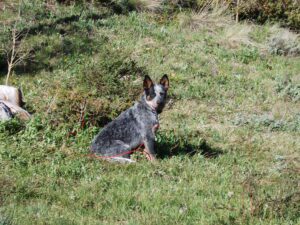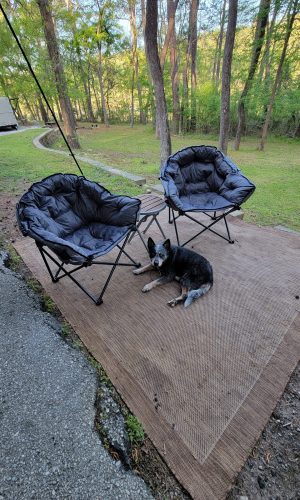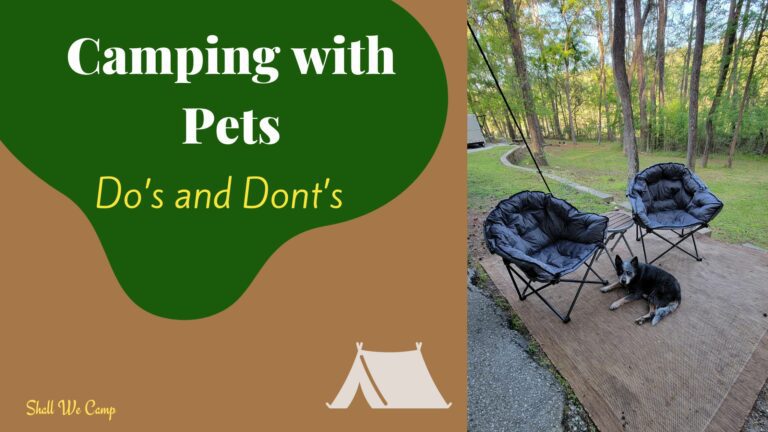For those of us that love to camp with our pets, doing a bit of homework before hitting the road can give you an idea of how pet-friendly your campsite will be. Not all campsites roll out the welcome mat for pets, so it's important to check if your chosen site is pet-friendly and understand any specific rules they might have. This could include leashing rules or areas off-limits to pets.
Packing for your furry companion requires more than just throwing in some kibble and calling it a day. You want to make sure that you've got everything from food and water bowls to a pet bed and toys. Don't forget essentials like a sturdy leash, poop bags, a pet blanket, and maybe even a portable pet tent depending on your destination.
The goal is to make them feel as homey as possible out there in the wild.
A quick visit to the vet before leaving is also a smart move. Confirming that your pet is up-to-date on vaccinations and flea/tick preventatives helps prevent potential health issues. Discuss your plans with your vet, as they might offer additional tips specific to your pet’s health needs or any camping-specific advice.
It's also a good idea to train your pet for the camping adventure. If your pet isn’t used to the great outdoors, familiarize them with what they might encounter. Practice basic commands like sit, stay, and come, and maybe take them on a few trial runs to the park or picnic areas. The main goal is to minimize surprises for your pet (and you) when you make it to the campsite.
Affiliate Disclaimer: This site contains affiliate links, which means I may earn a commission on purchases made through these links at no extra cost to you.
Table of Contents
Pet Safety and Comfort at the Campsite

When you finally arrive at your campsite, picking a safe zone to set up your tent is step one. Look for a spot that’s shaded and free from any potential hazards like sharp rocks or high cliffs. Avoid camping too close to any bodies of water unless your pet is trained and comfortable with such environments.
Setting up a comfy sleeping area for your pet is also important. Bring along a familiar pet bed or blanket. This not only keeps them cozy but also provides a sense of security with familiar smells from home.
You will want to make sure that you keep your pet’s thirst quenched and tummy full. Always have plenty of clean water available and consider bringing a travel-friendly water bottle or bowl. Stick to your pet’s regular diet to avoid any upset stomach mishaps.
Protect your pet from wildlife and environmental hazards like ticks or snakes. Always keep an eye out and maintain a respectful distance from wildlife. Packing a pet-safe insect repellent can help fend off the annoying bugs you might encounter.
Pet Etiquette: Manners and Responsibilities

Keeping your pet leashed and supervised is both a safety measure and a courtesy to other campers. Even the friendliest pup might get distracted by new smells and sights or other animals nearby. A leash makes sure that your pet doesn’t wander off and also helps you control their interactions with their surroundings.
Respecting other campers and wildlife involves more than just keeping your pet close. Make sure your pet isn’t disturbing others through excessive noise or by approaching strangers uninvited. Some people and animals might get startled or uncomfortable around pets they don’t know.
Proper waste disposal is an important responsibility of every pet owner. Carry enough waste bags and always clean up after your pet, disposing of the bags in designated areas or trash bins. This helps maintain the campsite cleanliness and reduces impacts on the environment.
If your pet tends to bark at unfamiliar sounds or visitors, consider bringing toys or treats to distract and calm them. Training techniques that encourage quiet behavior can also be beneficial.
Fun Activities to Enjoy with Your Pet

Exploring pet-friendly trails and nature areas is a fantastic way to spend your day. Many campsites offer marked trails that are safe for pets. Just make sure to check the guidelines and regulations for pets before setting off.
Engaging in interactive games like fetch or tug-of-war keeps your pet physically active and mentally stimulated. Bringing along a few favorite toys or balls can turn any open space into a playful arena where your pet can burn off some energy.
Teaching new skills or tricks can become a fun project during your trip. The relaxed outdoor setting can be a great backdrop for training sessions. Whether it's learning to fetch a stick or mastering a new trick, spending this focused time together strengthens your connection.
Camping is a perfect opportunity to enjoy simple distractions. Building stronger bonds happens naturally when you’re all cuddled up by the campfire, sharing a quiet moment under the stars. These shared experiences create lasting memories for both you and your pet.
Handling Emergencies and Challenges

Recognizing common camping hazards like extreme weather or poisonous plants can keep your pet safe while camping. Keep an eye on weather forecasts and familiarize yourself with the local flora to protect your pet from potential dangers.
Preparing a pet-specific first aid kit can make a huge difference in an emergency. Include essentials like bandages, tweezers for tick removal, antiseptic wipes, and any specific medications your pet might require.
If your pet gets lost, staying calm is important. Make sure they have a collar with an ID tag and consider getting them microchipped for an added layer of security. Having a recent photo on hand can also be useful in searching.
Handling pet anxiety and stress requires patience and understanding. If your pet seems anxious, try to identify the cause and offer comfort through familiar toys or gentle reassuring words. Planning for extra breaks during the trip can help them adjust more comfortably.
Check out my article on the 5 Best First Aid Kits for Camping. It's packed with essential gear recommendations to make your camping trips safe!
Final Thoughts
We love camping with our dog and over the years we've developed a routine with him that makes it so much easier. He actually looks forward to our camping trips and because we take precautions, our trips have gone off without a hitch (for the most part).
There was one time when Indy (our 14 year old Blue Heeler) got a nasty sting from some ground insect that we never saw. His face swelled up and he got very lethargic. Luckily it was towards the end of our trip, so we loaded him up and gave him some Benadryl for the ride home.

We always keep Benadryl in his dog bag for occassions like this as well as to help keep him calm. It works like a charm. The point of the story is that staying prepared and creating a stable routine while camping with your pet can make the experience enjoyable and safe.
We recommend packing a dog (or pet) bag for your furry friends. For dogs, consider packing an extra leash and collar just in case one breaks or gets lost. Also include a first aid kit for your pet. We like the Adventure Medical Kit – Trail Dog.
Since your pets are essentially members of your family, it makes sense to take them camping with you. Take the necessary precautions and plan accordingly and you will be prepared for a fun-filled, safe camping trip with your little fuzz-butts!





